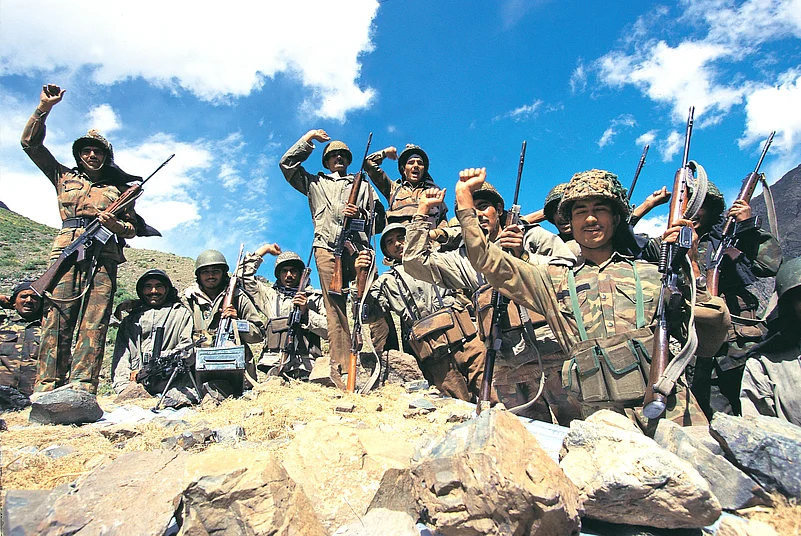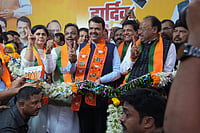As the nation celebrates with immense pride the Kargil Vijay Diwas, on the 25th anniversary of the war, it is also time to reflect on the lessons learned from the war and how they are shaping India's national security.
The Victory in Kargil extracted unparalleled sacrifices. Enshrined on the Roll of Honor of the Kargil War Memorial at Dras, are 32 Officers, 23 Junior Commissioned Officers, 488 Other Ranks and two porters, in all 545 warriors made the supreme sacrifice and more than double those numbers were severely wounded to defend the nation’s sovereignty. Bitterly fought over a frontage of just over 150 kilometres of the Line of Control, all the battles required fierce attacks over treacherous terrain in harsh weather conditions, to throw out enemy troops from well entrenched positions on sharp peaks at altitudes of 18,000 feet. The Kargil War is a symbol of total commitment and selfless service of the soldiers for the country.
Lesson 1 – Continually Review and Plug the Gaps being exploited by Pakistan
Kargil was yet another reminder that in Pakistan, we have an enemy who is perpetually looking for gaps in our preparedness and striking recurrently. No civilian political dispensation in Pakistan can function or survive without the support of the Pakistan Army. For the Pakistan Army to thrive, India must constantly be kept on the tenterhooks and provoked from time to time.
It must be recalled that, Pakistan undertook the Kargil misadventure in the immediate aftermath of the Lahore [Peace] Declaration made by two Prime Ministers - Vajpayee and Nawaz Sharif. Whether the then Pakistan Army Chief Pervez Musharaf kept Nawaz Sharif in the know of the Kargil operation or otherwise, is quite immaterial to the fact that the act was outrageously duplicitous, and it reiterated that in Pakistan, it’s the Army that rules the roost.
Despite the high political costs, the international contempt and isolation post Kargil, it didn’t deter Pakistan from carrying out adventurous terrorist attacks against India, such as the attack on the Parliament in 2001, Mumbai 2008, Uri 2016, Pulwama 2019 and the recent attacks in the Jammu division. Interspersed between these major terrorist attacks are repeated attempts to destabilise the situation in Kashmir by infiltrating terrorists, diverting assets from Afghanistan to Kashmir, local recruitment of terrorists and overground workers, Pakistan-sponsored agitations, stone pelting and subversion.
Post the abrogation of Article 370, the notion of peace and stability in Jammu and Kashmir has yet again been shattered by the spate of attacks in the Jammu division. In 2024 alone, 12 soldiers have made the supreme sacrifice in the Jammu Division, with lesser numbers of terrorists killed. While the security forces will eventually reset the current situation, the fundamental lesson from Kargil and later attacks continue to be relevant i.e. Pakistan is not giving up anytime soon, with every defeat it innovates newer ways and means to achieve the same end. To make matters worse, Pakistan is now virtually a vasal state of China. India’s strategy to deal with Pakistan needs constant reappraisal, which in turn requires sound intelligence and continuous professional and political oversight.
Lesson 2 – Intelligence Systems and Culture – need continuous improvement
The Kargil Review Committee had highlighted ‘a major intelligence failure’ and made several recommendations to fix the lacunae. Some measures have been implemented, for instance the National Technical Reconnaissance Organisation (NTRO) and the Defence Intelligence Agency (DIA) have come up and are making a difference. Nonetheless major incidents like Mumbai 2008, Uri 2016, Pulwama 2019, clashes along the LAC in Eastern Ladakh 2020 and the recent spate of attacks in the Jammu division point towards inadequacies in the intelligence systems and the intelligence culture across the national security apparatus. The intelligence challenge has multiplied manifold due to China’s belligerence.
In the period preceding the Kargil War, soon after the snow melt, graziers who had gone up to the heights had reported unusual activity in the area of the posts vacated during winters to avoid snow casualties. But these inputs unfortunately did not find their rightful place in the larger intelligence picture, similarly the surreptitious increase in the number of Pakistan’s Northern Light Infantry Battalions in the sector was missed out by the intelligence agencies. The security apparatus was too firm in their belief that the inhospitable terrain and harsh weather precluded any incursion. The Pakistanis exploited this mindset to occupy heights that dominated the National Highway connecting the Kashmir region with Ladakh region, in the hope that they could disrupt or cutoff this major artery at will.
Today, technology allows high volumes of information to flow quickly, easily. The big picture can be swiftly pieced together digitally, with little human intervention. The intelligence culture of operating in silos, mutual mistrust and secrecy, aggravated by a hierarchical structure must reform to be able to leverage technology and improve response. At the highest level, the National Security Council must be much more proactively involved with intelligence and the state of national security. In the absence of regular intelligence briefing of the National Security Council, crisis management becomes the norm which is detrimental to national security interests. Regular periodic intelligence briefings would enable more thought through responses and save both blood and money.
Lesson 3 – National Security Governance is about long-term planning and preparation
During the Kargil War, the National security apparatus was in a crisis management mode, reacting to inputs coming in from the frontlines and the intelligence agencies. Reactions were arguably kneejerk and cautious. The decision not to cross the Line of Control to ‘avoid escalation’, may have earned accolades for restraint, but it cost the nation many more lives, as it limited the space for manoeuvre essential for forces in the field and also integrated application of military power. The situation has improved, as witnessed both in the response to the Uri attack in 2016 and Pulwama in 2019. The Government did not hesitate to cross the Line of Control to respond on both the occasions.
The National Security Adviser’s (NSA) office and the National Security Council Secretariat are far more empowered and evolving with changing times. The NSA holds the rank of a Cabinet Minister and is supported by an additional NSA, three Deputy NSAs, Military Adviser, Chief Cyber Security Coordinator and National Maritime Security Coordinator. In addition, there is a full-fledged National Security Advisory Board.
In 2018, the Government established a Defence Planning Committee (DPC) under the chairmanship of the NSA. This institutional mechanism, set up as a permanent body, is intended to “facilitate a comprehensive and integrated planning for defence matters”. The close relationship between warfare and high tech is widening the spectrum of conflict, and expanding the domains of warfare, to include – Space; Outer & Near, electromagnetics, cyber, air, land, sea, connectivity networks, and the cognitive domain. The DPC needs to be energised immediately to enable integrated long-term planning at the national level, and pragmatic capability development to be able to deal with the entire spectrum of threat.
Lesson 4 – Just Do It! - From Jointness to Integration
Drawing from the Kargil Review Committee, in 2001 the Group of Ministers had recommended creation of the post of Chief of Defence Staff. After nearly two decades of dithering, the Government finally created the post in 2019. The Inter-Services Organisations (Command, Control and Discipline) Act empowering Commanders-in-Chief and Officers-in-Command of Inter Services Organisations to exercise control over Service personnel serving under them, has been notified earlier this year.
It is taking too long to create the integrated theatre commands and other facets of inter service integration like training and logistics. The impediments posed by ‘service parochialism’ have to be overcome by enforcing top-down reform in the interests of national security. Inter service integration is no longer the end, but the means to meet future threats that require a ‘whole of nation’ approach.
Lesson 5 – ‘Equipped to Fight’ not ‘fight with what we have’
In the run up to the Kargil War, the armed forces required considerable ‘firefighting efforts’ to make up equipment voids. The story repeated itself post the Uri attack in 2016 and the clashes with PLA in 2020. Fundamental to this problem is the absence of clear ‘role distinction and accountability’ for creating capability for the armed forces. This lacunae needs to be fixed first. The entire capability development ecosystem from Defence R&D, production, procurement and life cycle sustenance needs combined strategic and scientific direction to keep pace with the changing character of war and evolving threats. Needless to reiterate that the oxygen for the capability ecosystem is ‘budgetary support’ which must come with the right tools to ensure ‘value for money’.
The experience of recent wars has also shown that there is a period of initial surprise and being caught off guard. While the forces manage to recover from the adverse situation by adaptation in tactics, techniques, and procedure in the battlefield, it comes with significant casualties and operational losses. This phenomenon can be largely attributed to the reluctance to reform, and an inadequate connect between the rapid explosion of technologies and asymmetric warfare at play on one hand, and time-tested war fighting doctrines on the other. This must change.
As we celebrate Kargil Vijay Diwas, let the memory of each brave Kargil warrior remind us of the hard-earned victory. Let the supreme sacrifices guide us towards a larger duty in the interests of the nation.
Views expressed are personal.
The author is Former Deputy Chief of Army Staff, GOC Kashmir Corps and Member National Security Advisory Board.


















